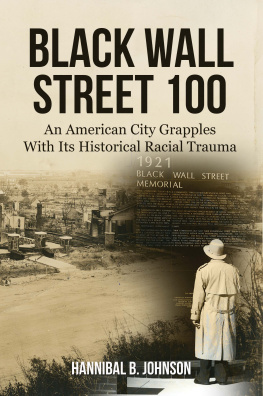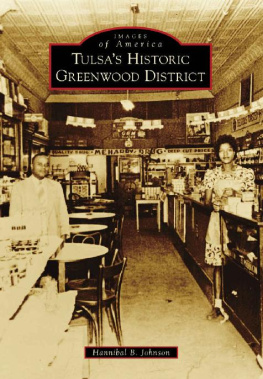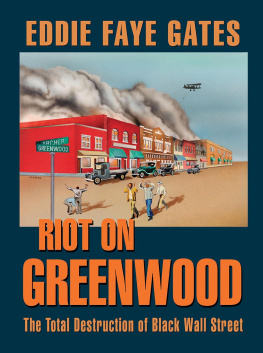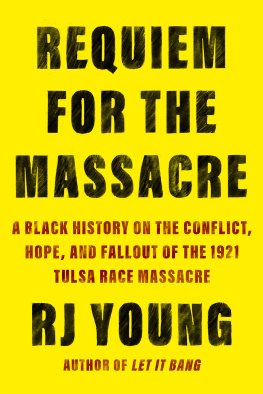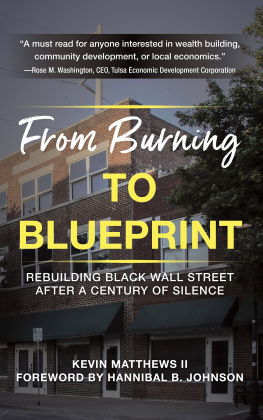Contents
Pagebreaks of the print version

BLACK WALL STREET
An American City Grapples With Its Historical Racial Trauma
Hannibal B. Johnson



| Copyright 2020 By Hannibal B. Johnson Published By Eakin Press An Imprint of Wild Horse Media Group P.O. Box 331779 Fort Worth, Texas 76163 1-817-344-7036 www.EakinPress.com ALL RIGHTS RESERVED 1 2 3 4 5 6 7 8 9 ISBN-13: 978-1-68179-183-8 Print ISBN: 978-1 -68179-179-1 |
ALL RIGHTS RESERVED. No part of this book may be reproduced in any form without written permission from the publisher, except for brief passages included in a review appearing in a newspaper or magazine.
Table of Contents
Acknowledgments
No one who achieves success does so without the help of others. The wise and confident acknowledge this help with gratitude.
Alfred North Whitehead
Special thanks to those persons who assisted with various aspects of this project, including manuscript review, editing, photography, and substantive content. Those individuals include: Dr. Vivian Clark-Adams, Jack Blair, Mayor G.T. Bynum, I. Marc Carlson, T.D. Pete Churchwell, Richard DeSirey, George A. Farrar, Jr., Joan Hoar, Frances Jordan-Rakestraw, Ken Levit, Darrell Mercer, Calvin C. Moore, J.D., Ph.D., Joseph L. Parker, Jr., Gary Percefull, Senator Kevin L. Matthews, Steve Wood, the 400 Years of African American History Commission, and the 1921 Tulsa Race Massacre Centennial Commission.
Historyinclusive, unvarnished, and authenticis best when looked at, learned from, and leveraged. Indeed, it is not possible to blaze the trails to our future without first retracing the footsteps of our past.
This book is the culmination of years of effort, not just on the part of the author, but by many individuals and groups committed to forward momentum in Tulsa, in race relations and more broadly. I am grateful.
Prologue
Whats past is prologue.
William Shakespeare
Walter White, Assistant Secretary of the National Association for the Advancement of Colored People, commonly known as the N.A.A.C.P, visited Tulsa in the spring of 1921. He described the city and its racial dynamics in a June 1921 magazine article.
A hysterical white girl related that a nineteen-year-old colored boy attempted to assault her in the public elevator of a public office building of a thriving town of 100,000 in open daylight. Without pausing to find whether or not the story was true, without bothering with the slight detail of investigating the character of the woman who made the outcry (as a matter of fact, she was of exceedingly doubtful reputation), a mob of 100-per-cent Americans set forth on a wild rampage that cost the lives of fifty white men; of between 150 and 200 colored men, women and children; the destruction by fire of $1,500,000 worth of property; the looting of many homes; and everlasting damage to the reputation of the city of Tulsa and the State of Oklahoma.
This, in brief, is the story of the eruption of Tulsa on the night of May 31 and the morning of June 1. One could travel far and find few cities where the likelihood of trouble between the races was as little thought of as in Tulsa. Her reign of terror stands as a grim reminder of the grip mob violence has on the throat of America, and the ever-present possibility of devastating race conflicts where least expected.
Tulsa is a thriving, bustling, enormously wealthy town of between 90,000 and 100,000. In 1910 it was the home of 18,182 souls, a dead and hopeless outlook ahead. Then oil was discovered. The town grew amazingly. On December 29, 1920, it had bank deposits totaling $65,449,985.90; almost $1,000 per capita when compared with the Federal Census figures of 1920, which gave Tulsa 72,076. The town lies in the center of the oil region and many are the stories told of the making of fabulous fortunes by men who were operating on a shoe-string. Some of the stories rival those of the forty-niners in California. The town has a number of modern office buildings, many beautiful homes, miles of clean, well-paved streets, and aggressive and progressive business men who well exemplify Tulsas motto of The City with a Personality.
So much for the setting. What are the causes of the race riot that occurred in such a place? First, the Negro in Oklahoma has shared in the sudden prosperity that has come to many of his white brothers, and there are some colored men there who are wealthy. This fact has caused a bitter resentment on the part of the lower order of whites, who feel that these colored men, members of an inferior race, are exceedingly presumptuous in achieving greater economic prosperity than they who are members of a divinely ordered superior race. There are at least three colored persons in Oklahoma who are worth a million dollars each; J. W. Thompson of Clearview is worth $500,000; there are a number of men and women worth $100,000; and many whose possessions are valued at $25,000 and $50,000 each. This was particularly true of Tulsa, where there were two colored men worth $150,000 each; two worth $100,000; three $50,000; and four who were assessed at $25,000. In one case where a colored man owned and operated a printing plant with $25,000 worth of printing machinery in it, the leader of the mob that set fire to and destroyed the plant was a linotype operator employed for years by the colored owner at $48 per week. The white man was killed while attacking the plant. Oklahoma is largely populated by pioneers from other States. Some of the white pioneers are former residents of Mississippi, Georgia, Tennessee, Texas, and other States more typically southern than Oklahoma. These have brought with them their anti-Negro prejudices. Lethargic and unprogressive by nature, it sorely irks them to see Negroes making greater progress than they themselves are achieving.
One of the charges made against the colored men in Tulsa is that they were radical. Questioning the whites more closely regarding the nature of this radicalism, I found it means that Negroes were uncompromisingly denouncing Jim-Crow [railroad] cars, lynching, peonage; in short, were asking that the Federal constitutional guaranties of life, liberty, and the pursuit of happiness be given regardless of color. The Negroes of Tulsa and other Oklahoma cities are pioneers; men and women who have dared, men and women who have had the initiative and the courage to pull up stakes in other less-favored States and face hardship in a newer one for the sake of greater eventual progress. That type is ever less ready to submit to insult. Those of the whites who seek to maintain the old white group control naturally do not relish seeing Negroes emancipating themselves from the old system.

